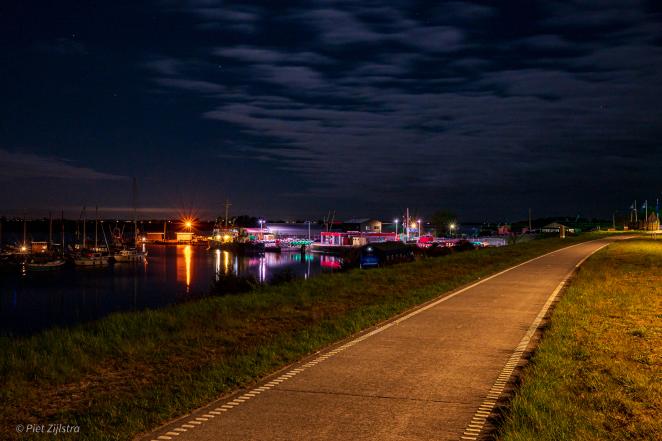
Photo: Piet Zijlstra
Inspiration drives us to initiate change and develop new solutions. We draw motivation from innovative success stories, which is precisely what we aim to share through our Good Practice Stories. From our project region across the North Sea coast, we’ve gathered diverse examples of light pollution mitigation efforts. Each story highlights a unique approach to reducing light pollution, reflecting the various perspectives and needs that shape lighting choices. Balancing these demands can lead to a range of creative solutions. With this collection, we hope to offer valuable insights into these different strategies, discover new perspectives and inspire readers to discover their own paths to action.
Read our first story about the unique community engagement in Lauwersoog, the Netherlands:
Giving Darkness, Not Taking Light: Engaging Everyone for a Darker Sky
Lauwersoog, a seaside village nestled on the edge of the Wadden Sea, has always been a place where land and water intertwine. But recently, it faced a dilemma: How could it keep its dynamic harbour economy running safely while preserving the tranquillity of the night sky?
In this active harbour community, light is essential. It guides ships safely into the harbour, illuminates neighbourhood streets and ensures the safety of residents, visitors and harbour workers. But there’s a catch. Lauwersoog lies very close between the highly protected Wadden Sea UNESCO World Heritage site and the Lauwersmeer Dark Sky Park. That means that every artificial beam of light has consequences. It spills into the natural darkness, disrupting predator-prey dynamics, confusing the navigation of local and migratory species and unsettling their reproductive patterns, ultimately impacting entire ecosystems. Beyond its toll on wildlife, light pollution also disturbs our circadian rhythms and well-being. This issue takes on added urgency as the Netherlands ranks as Europe's third most light-polluted country. Despite many other successful initiatives protecting local nature, the challenge of addressing light pollution remained yet unaddressed in Lauwersoog.
Enter the “Masterplan Darkness”. It’s not a cloak-and-dagger operation or imposed new decree; rather, it’s a community-driven strategy to strike a delicate balance. The motto? “Giving darkness, not taking light.” The goal? To protect nature without casting the village into total darkness.
Inducement stemmed from other successful sustainability initiatives in the region and was motivated by the allure of the Dark Sky Park. As part of the DARKER SKY Project, a dedicated harbour project team was ready to act. A first inventory revealing excessive light pollution in Lauwersoog's harbour initially stunned the community. But it quickly spurred them into action.
So, the Masterplan didn’t emerge from a secret council chamber. Instead, it unfolded amidst the community. Residents, business owners and environmentalists came together in meetings, discussing concerns and sharing perspectives to develop a plan for change.
They discussed light levels, safety concerns and the delicate dance between safety, progress and preservation. The result? A blueprint masterplan that harmonized human health and safety, economic vitality and environmental stewardship. This initial planning focuses on renewing the lighting in Lauwersoog, with the harbour area taking centre stage. Yet, the vision extends beyond the harbour—it envelops the village also. Over the next year, dark-sky-friendly lighting will replace outdated fixtures at areas like harbour piers, docks, building exteriors and village streets. Height, colour, shielding and brightness—all carefully considered features—will contribute to this transformative change towards a 50% light emission reduction by 2026.
But the Masterplan Darkness isn’t just about wattage, lux and lumens. It is about hearts and minds. The community needed to see darkness as a gift, not a loss. The project team is currently launching educational campaigns, motivating everyone to dim lights of their ships, turn off late-night advertisements or interior lighting and embrace energy-efficient alternatives. By showing the positive outcomes, like better health and biodiversity, the community became more supportive and excited about the plan.
How's the progress so far? The responses have been overwhelmingly positive. Early adopters —businesses and residents alike—have enthusiastically embraced the change. They've shown full commitment by already reducing their light emissions either by changing or switching off their business or private lighting. This initiative has leveraged the community's existing environmental awareness, strengthened bonds and is propelling them toward new sustainable goals. And neighbouring ports? They perked up, curious about this village that dared to redefine progress and expressed interest in joining dark sky protection efforts.
Lauwersoog dreams big. As a community driven demonstrator site of the DARKER SKY project, it envisions itself as a model—a place where industry, recreation and nature coexist harmoniously. By celebrating darkness, not fearing it and embracing the balance between people, economy and nature, this little harbour hopes to inspire others across the whole North Sea region. Perhaps one day, as towns across the region look up to their own star-filled skies, they will find inspiration in Lauwersoog's commitment to giving darkness, not taking light.
Author: Anna Vollmer
Use of AI: ChatGPT, COPILOT and Hemingway were used to improve the writing
